Trudy J. Morgan-Cole's Blog, page 38
March 18, 2021
My Biggest Lie of 2020
I’m usually a pretty honest person, partly because of morals and partly because I’m a terrible liar. But 23 years ago, when I became a parent, I discovered that parenthood ushered in a whole new era for me, one in which lying often made things easier for everyone, and lies were told to an audience so gullible they would believe things like, “We don’t have any ice cream” (we did); “McDonalds isn’t open” (it was), and my personal favourite, “The toys live here at the store; they can’t come home with us.” I had my kids convinced ToysRUs was basically a museum where you could go to gawk but never remove anything. That schtick only worked till they were about 4 or 5, but it was good while it lasted.
As kids get older, I had to treat them like other people — i.e., not lying to them. When kids are teens and young adults, for me, anyway, there’s basically only one parental lie you can get away with: “It’s going to be OK.”
You can get away with this lie because they kind of know it’s a lie too. I mean, they know you can’t actually guarantee things will be OK. Saying it is an expression of hope, but you say it like a promise, because as a parent, for so long your job was to make things OK.
This time last year, March 18, 2020, I was not sure everything would be all right. I had one child getting ready to drive home by herself from Nova Scotia after her university suddenly closed. I had another child, whose local college had also moved to online classes, living alone in a small apartment. I had an elderly dad, also living alone, who was at high risk for COVID. I knew that once Emma came home, Jason and I would quarantine with her, which we were prepared for, but it meant we couldn’t do anything to help my dad or Chris if any needs arose during those two weeks. Like everyone else, I had no concept of how long this might last or what the future might look like.
On March 20, I dropped by to visit my dad, and to visit Chris — dropping off some supplies, touching base before we went into quarantine, all the while checking my texts to see how Emma was doing on her drive home. At Chris’s place, I visited with him and his beautiful cats, grateful he would at least have them for company.

Chris was worried, like Emma was, like all the young adults were. What would this mean for their education, their social lives, their world? Beyond encouraging Chris to stay in his apartment as much as possible, I didn’t have many answers, but I repeated that familiar lie, “I’m sure everything will be OK. It won’t last too long.”
Chris said, “There’ll be a vaccine, right? I heard they’re already working on a vaccine. So there’ll probably be one before too long.”
That was the point at which I told my biggest lie of 2020. I said, “Yeah, I’ve heard that too. The scientists are on it, so there’ll be a vaccine before long.”
I knew it was a lie because I knew there’d never been a vaccine for a coronavirus before. I knew vaccines took years, not months, to be developed, to be tested, to be approved. I’d read up on it, even that early in the pandemic, and I knew that the rosiest estimates were that a COVID-19 vaccine, if it ever came, would likely be 3 or 4 years out. And nobody knew how either we or the virus would adapt until then.
I lied to my brilliant, beautiful, worried young adult son because I couldn’t shake that parental urge to tell my kids that it will be OK. Even in the face of the unprecedented, the uncertain. I knew whatever got us through this, it wouldn’t be a super-fast vaccine riding in to save the day.

Today, March 18, 2021, life has changed a lot. We’re wearing masks. Most of Emma’s and Chris’s 2020-2021 school years have been online learning, although they’ve both managed to have some in-person class. We’ve all spent more time in our homes than we expected we would. And today, March 18, 2021, I went with my dad to get his first shot of the Pfizer vaccine.
It was an absolutely, boldfaced, barefaced lie when I said a year ago that we’d have a vaccine before too long. A lie, or, if you will, a statement of hope. An audacious hope that appears to have actually come true. Our senior citizens have begun to get vaccinated. In a few months, most of the rest of us will have been. The pandemic is a long way from over, but the end is in sight. And a scientific miracle — a combination of work and genius and will and resources and cooperation such as we rarely see in this divided world — made it happen.
I’m glad I wasn’t lying after all.
March 12, 2021
The Suckiversary
Yesterday, March 11, 2021, was the one-year anniversary of the day the WHO declared COVID-19 a global pandemic. Canada declared a day of mourning and remembrance for the more than 22,000 people who died of COVID in that last year.
I remember March 11, 2020 — still three days before we got our first case in NL, and I was taking my usual, “It’s probably not a big deal, might not even affect us” approach. But the news that it had been declared a pandemic did make me pause and think, “Could this get bad here?” That was the week we were hearing the horrific reports out of Italy, and I recall wondering, “Could that happen here?”
It did; also, it didn’t.
Yesterday afternoon, a local radio station asked on Twitter, “How are you feeling a full year later?”
As is the way with my social media interactions, I tapped out a quick four-tweet reply on Twitter … then thought it over/refined it some more and posted it on Facebook … and then figured I’d put what I wrote here on my blog so I could easily find it when I want to look back at the milestones of this year.
Here’s what I was thinking yesterday, one year after the declaration of a global pandemic:
****
Of course, who (other than a sociopath) could NOT be feeling the tragedy and the weight of the 22,360 Canadians, and 2.6 million people worldwide, who have died because of this virus? It’s appropriate to take a day to remember and mourn, and hope that the end is in sight. Along with that …Friggin’ grateful to live in Newfoundland, if I’m being 100% honest, is the main thing I’m feeling on this suckiversary.Grateful our province has gotten through 365 days with only 6 COVID deaths in a population of 500,000+Grateful to have been able to enjoy nearly-normal life with very minimal restrictions from June 2020 – Feb. 2021.Grateful for no outbreaks in long-term care.Grateful my elderly and immunocompromised loved ones have been at much, much lower risk than they would have been in other places during this year.It’s interesting that Newfoundland didn’t set out, when all this began, to pursue a “zero COVID” strategy. Our public health measures in March 2020 were aimed at “flattening the curve” to prevent the healthcare system from becoming overloaded, which we’d all been told was the goal.
But once we found out, after the funeral-home cluster of cases and several weeks into that original lockdown, that it was possible for case counts to go down to zero and stay there, there didn’t seem to be a willingness on the part of the people to risk more outbreaks and the severe illness and death that would go along with them. Continued (though regularly easing) restrictions and, most importantly, travel bans, kept us effectively at zero COVID (except for isolated travel cases that did not cause any spread), from May 2020 until February 2021.
The takeaway, one year later, from our experience in NL and from many other places that have achieved near COVID-zero, is that it definitely IS possible — but there’s a high cost to achieve that.
Was the cost worth it? I look at the numbers, at the gratitude I’m feeling for all the things I listed above, and for me the answer is a resounding yes.
But I don’t want to downplay that cost. This year in Newfoundland and Labrador has been incredibly hard for a lot of people, and I understand why some people question whether it’s been worth it.
For me, not getting to hop on a plane and travel somewhere, having to wear a mask to the store, not going to see live theatre — these things are inconvenient but not genuine hardships.
A rotational worker who has to spend weeks isolating away from family, over and over; a small business owner who saw their lifelong dream shop or restaurant close because they couldn’t survive the financial losses of lockdown; anyone who had to say goodbye to a dying loved one by phone or Facetime instead of being able to get to the hospital to sit with them; grandparents who didn’t get to hold the new grandbaby for months; a sick person whose waiting list for an “elective” procedure has dragged on months longer than expected … these people have all truly paid the cost of our battle against COVID. Not to mention the healthcare workers and other frontline first responders, and all that has been asked of them in the last year.
This time has demanded great sacrifices from all, but sacrifices in any hard time — wars, natural disasters, pandemics — are never distributed equally. As someone who’s had to make relatively few sacrifices for the safety we’re enjoyed, I recognize the cost of what we’ve achieved in the last 365 days. I respect those who’ve paid that price, and even though I disagree with them, I understand where people are coming from when they say pursuing a zero-COVID strategy came with too high a price.
One year in, yes, I’m feeling incredibly tired of it all, hoping for vaccines to put an end to it soon. I’m eager to travel and go to concerts and plays and live “normally” again — I’m also eager for all those people who’ve paid a much higher price this year than I have, to get back at least some of their normal — for rotational workers to come and go without needing to isolate, for the healthcare system to clear that backlog of delayed surgeries and procedures, for local businesses to recoup some of their losses.
Yes, I’m aware that mistakes have been made, that our leadership has been far from perfect, and that we have big, non-COVID problems as a province that still have to be faced. And, of course, a provincial election that still apparently hasn’t ended.
But mostly, I’m grateful. Because, even with all the above being true, I would rather have spent this year here on this island than anywhere else in North America.
Hold fast, and all that.
March 8, 2021
Four Hundred Souls, edited by Ibram X. Kendi and Keisha N. Blain
 This book, which I’ve been reading a few sections at a time throughout Black History Month and now a little bit into March, was a wonderful companion volume to Ibram X. Kendi’s Stamped from the Beginning. This book, edited by Kendi and by Keisha N. Blain, covers the same time period — the 400 years since the first enslaved Africans were brought to the British North American colonies, up to the present day — as is covered in Stamped from the Beginning. But rather than one author’s detailed examination of the history of racism, race relations, and racist ideas over those 400 years, Four Hundred Souls is, as the subtitle says, a “community history.” Dividing those four hundred years up into five-year periods, the editors assigned 80 different Black authors from various backgrounds (as well as several poets whose poetic pieces appear at different points throughout the book) to each write a short essay about a person, an incident, or some aspect of African-American life during their assigned five-year period. The result is a multilayered text that provides a rich overview of African American history from a variety of perspectives and viewpoints, always enlightening, challenging, troubling and inspiring.
This book, which I’ve been reading a few sections at a time throughout Black History Month and now a little bit into March, was a wonderful companion volume to Ibram X. Kendi’s Stamped from the Beginning. This book, edited by Kendi and by Keisha N. Blain, covers the same time period — the 400 years since the first enslaved Africans were brought to the British North American colonies, up to the present day — as is covered in Stamped from the Beginning. But rather than one author’s detailed examination of the history of racism, race relations, and racist ideas over those 400 years, Four Hundred Souls is, as the subtitle says, a “community history.” Dividing those four hundred years up into five-year periods, the editors assigned 80 different Black authors from various backgrounds (as well as several poets whose poetic pieces appear at different points throughout the book) to each write a short essay about a person, an incident, or some aspect of African-American life during their assigned five-year period. The result is a multilayered text that provides a rich overview of African American history from a variety of perspectives and viewpoints, always enlightening, challenging, troubling and inspiring.
Stamped from the Beginning, by Ibram X. Kendi
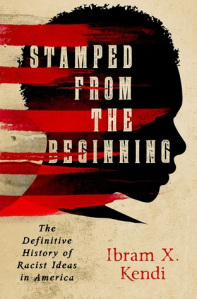 This book took me quite a while to read because I had it out as an audiobook from the library, and it’s very long and the loan ran out before I’d finished it. Then it was so popular it was a long wait to check it out again! But finally, in two widely-separated loan periods, I got through this massive, thoroughly researched tome about, as the subtitle says, “The Definitive History of Racist Ideas in America.”
This book took me quite a while to read because I had it out as an audiobook from the library, and it’s very long and the loan ran out before I’d finished it. Then it was so popular it was a long wait to check it out again! But finally, in two widely-separated loan periods, I got through this massive, thoroughly researched tome about, as the subtitle says, “The Definitive History of Racist Ideas in America.”
First, to address one criticism I’ve seen of this book: no, that subtitle is not fully accurate. It is, specifically, the definitive history of anti-Black racism in America, beginning back in the earliest colonial period in what became the United States, and exploring how the importation of enslaved Africans, and the development of racist ideas that were necessary to justify the slave trade, planted the seeds for 400+ years of anti-Black racism in the US.
Ibram X. Kendi’s approach to organizing this book is unique — the book is divided into five sections, each given the name of a different person whose life and ideas had an impact on the development of racism and race relations in America. The five characters are three white men: Puritan preacher Cotton Mather (1663-1728), founding father Thomas Jefferson (1743-1826), abolitionist William Lloyd Garrison (1805-1879); one Black man, sociologist W.E.B. DuBois (1868-1963); and one Black woman, activist Angela Davis (b. 1944). But the sections are not biographies of those writers, thinkers and activists, though in most cases a fair degree of biography does get included: rather, each section of the book is an examination of a time period in American history, and the person whose name heads the chapter is taken as one key thinker among many whose ideas — whether racist or anti-racist — were emblematic of the questions being asked and answers being offered in American race relations during that time period.
It was incredibly helpful to me to have previously read Kendi’s How to be an Antiracist before reading this book, to be familiar with his thesis that it’s not possible to simply be “not racist”: people, policies, and ideas are either actively racist or actively anti-racist, and the same people can be anti-racist at some points in their lives and in some of their ideas, while being racist in other ways by continuing to promote racist ideas and stereotypes (and, Kendi argues, some of these racist ideas are promoted by Black people as well as by well-meaning white people who are trying to be anti-racist — most commonly when they promote ideas he labels “assimilationist” by trying to make Black Americans “fit in” with the standards of white society or somehow come “up” to the level of white people). I found these distinctions he makes really useful, and already understanding how he was using these terms helped me to grasp many of his arguments in this book better than I might have otherwise.
This is a vast, sweeping, ambitious and powerful look at the history of anti-Black racism in the United States, and I would consider it a must-read for anyone interested in this history.
Girl, Woman, Other, by Bernardine Evaristo
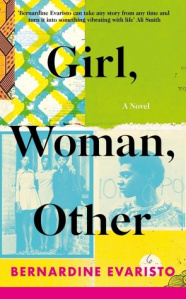 Back around the time this novel won the Booker Prize (or half-won? It was one of the rare times the prize was split, between Bernardine Evaristo and Margaret Atwood for The Testaments), I put it on my to-read list (that endless Goodreads document with over 300 titles on it forever, no matter how many of them I read), and I also put a hold on the e-book at the library. The hold actually came due in April of last year, when we were in First Lockdown of Early Pandemic, and I looked at the image of the cover on my screen and thought, “This is a Booker Prize winner. This is going to be an Important Book, full of Deep Thoughts and Clever Writing. And I cannot. I just cannot.” I let the hold go back to the library, something I almost never do, and went on re-reading the Lord Peter Wimsey books, which was pretty my all my brain was capable of, reading-wise, last spring.
Back around the time this novel won the Booker Prize (or half-won? It was one of the rare times the prize was split, between Bernardine Evaristo and Margaret Atwood for The Testaments), I put it on my to-read list (that endless Goodreads document with over 300 titles on it forever, no matter how many of them I read), and I also put a hold on the e-book at the library. The hold actually came due in April of last year, when we were in First Lockdown of Early Pandemic, and I looked at the image of the cover on my screen and thought, “This is a Booker Prize winner. This is going to be an Important Book, full of Deep Thoughts and Clever Writing. And I cannot. I just cannot.” I let the hold go back to the library, something I almost never do, and went on re-reading the Lord Peter Wimsey books, which was pretty my all my brain was capable of, reading-wise, last spring.
This spring finds me back in lockdown but in a much better headspace, and when I saw that an online book club in which I sometimes participate was reading Girl, Woman, Other, I checked to see if there was still a long waitlist for it at the library. And behold! It was available immediately.
I am so glad I gave this book a second chance when I was in the right frame of mind to read it, because I absolutely loved it and raced through it in a day. I asked some of the book club folks who’d already read it whether it was a novel or a collection of linked short stories, but it turns out that’s a hard question to answer. There are twelve sections of the book, each focused around a different woman (almost all Black British women, some of them LGBTQ), but they are not exactly twelve short stories, in that none of them really has the structure of a typical short story — rather, they are the life stories of these twelve fictional women, whose lives intersect with each other at various points.
This means that the book, overall, also doesn’t have the structure of a novel, and I’ve heard it described as having very little plot. This is true, on one level. I can tell you very briefly everything that happens in the actual present timeline of this novel (with no spoilers): a middle-aged playwright named Amma has written a play which is having its opening night at the National Theatre in London, making it the biggest debut of Amma’s career. Some of the characters in the novel attend Amma’s opening night, while others hear about it. Some of the people who attend interact with each other at the after party. That’s it. That’s the entire plot of the whole book — on one level.
But, of course, it’s so much more than that. Each of the women’s stories is a whole life, replete with incident, with brilliant detail, with masterful strokes of characterization. I was captivated by each story as I read it, entirely drawn into each woman’s world. It was especially fascinating when a woman who was only a minor, background character in one of the stories would then step forward to be the central character in another: the reader sees outside the frame of each story and behind the scenes to see how these women’s lives interact, intersect, and influence each other.
Each woman’s story is, as the title says, a story of what it means to be girl, woman, and other. Race is always central to these stories: they are not just about being a woman but (in every case but one) about being a Black woman. They are also about: being an immigrant, being poor, being rich, being in love, being rejected, being queer, being straight, being nonbinary, being young, being — and getting — old, being ambitious, being disappointed, being an artist, being respectable, being marginalized, being alive. The stories skirt and embrace and intertwine around each other, exploring so many aspects of life it’s hard to believe they all fit inside the covers of one book. And although Evaristo does many of the things that I find annoying and pretentious in lesser writers — dispensing with quotation marks and indeed with many punctuation marks, using sentence fragments and short, disjointed paragraphs and often even dropping capital letters where you’d expect to see them — none of this bothered me; I was so drawn into every story that I found them all completely compelling to read.
There is no “climax” as such — nothing huge happens when (many of) the characters come together at Amma’s opening night; there is no catastrophic confrontation to bring together all these varying characters with their different worlds. There are tiny encounters which are often poignant in light of what we’ve learned in the preceding stories, but the biggest emotional punch at the book’s end comes from one of the characters who is the most peripheral to the others and perhaps the least sympathetic to the reader, who makes a discovery that might just force her to rethink everything about how she sees the world. Or maybe it won’t, because people don’t, always. But it will at least adjust the reader’s expectations a little, something that this book is constantly doing, challenging what we think we know about these women and the lives they live.
March 7, 2021
The Beekeeper of Aleppo, by Christy Lefteri
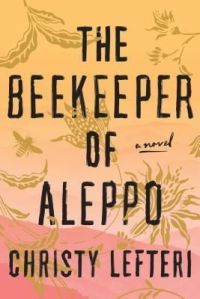 This is a powerful novel about a couple of Syrian refugees, Nuri and Afra, a married couple fleeing their home after their lives have been destroyed around them. It traces their journey from Aleppo through various refugee camps, over a dangerous ocean crossing from Turkey to Greece, and into the hands of smugglers who promise to be able to get them to the UK, a notoriously difficult country to enter as refugees but one where Nuri’s cousin and partner in the beekeeping business, Mustafa, has gone on ahead and is supposed to be waiting for him.
This is a powerful novel about a couple of Syrian refugees, Nuri and Afra, a married couple fleeing their home after their lives have been destroyed around them. It traces their journey from Aleppo through various refugee camps, over a dangerous ocean crossing from Turkey to Greece, and into the hands of smugglers who promise to be able to get them to the UK, a notoriously difficult country to enter as refugees but one where Nuri’s cousin and partner in the beekeeping business, Mustafa, has gone on ahead and is supposed to be waiting for him.
The author, Christy Lefteri, wrote the novel based on her experience working with Syrian refugees during the height of the refugee crisis there during the mid-late 2010s, and the details feel authentic and often harrowing to read about. At its heart, though, this book is a moving exploration of a two people and a marriage surviving through trauma and unthinkable loss.
Dusk, Night, Dawn, by Anne Lamott
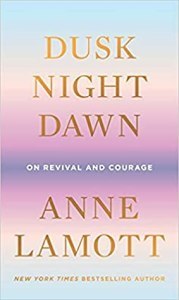 Once again, another in the series of short essay collections Anne Lamott has been doing for the last several years — this one focusing on resilience in difficult times. Surprisingly, she doesn’t have much to say about the COVID-19 pandemic — she references it a few times, but doesn’t, for example, tell any stories about being in lockdown, which makes me think the book was probably mostly completed and delivered to the publisher before last March. She does write about being a newlywed (for the first time) in her 60s, about the California wildfires, a tiny bit (not much) about living in Trump’s America, about the fear of climate change, about being a grandparent, about loving and losing pets — about all the messy reality of life and how we pull together and move forward through it all. In other words, Anne Lamott is continuing, in this latest book, to do what she does best.
Once again, another in the series of short essay collections Anne Lamott has been doing for the last several years — this one focusing on resilience in difficult times. Surprisingly, she doesn’t have much to say about the COVID-19 pandemic — she references it a few times, but doesn’t, for example, tell any stories about being in lockdown, which makes me think the book was probably mostly completed and delivered to the publisher before last March. She does write about being a newlywed (for the first time) in her 60s, about the California wildfires, a tiny bit (not much) about living in Trump’s America, about the fear of climate change, about being a grandparent, about loving and losing pets — about all the messy reality of life and how we pull together and move forward through it all. In other words, Anne Lamott is continuing, in this latest book, to do what she does best.
February 20, 2021
The Girl With the Louding Voice, by Abi Dare
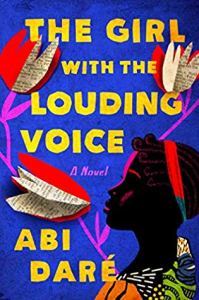 I absolutely loved this novel about a teenage girl in a Nigerian village who is forced into marriage with a much older man who already has two wives, but who still dreams that somehow she will get free to pursue an education and a career. The thing that makes this book such a joy is the totally fresh and believable voice of Adunni, made all the more powerful because the book is written in Adunni’s dialect, so it’s as if you can hear her speaking right in your ears. (You can also notice the so-gradual-it’s-almost imperceptible change in her narrative voice later in the story when she does get a bit more education). Terrible things happen to Adunni, and yet she remains this buoyant, fierce, and optimistic character throughout it all. I really loved this book, loved Adunni, and will definitely read another book but Abi Dare when she comes out with one.
I absolutely loved this novel about a teenage girl in a Nigerian village who is forced into marriage with a much older man who already has two wives, but who still dreams that somehow she will get free to pursue an education and a career. The thing that makes this book such a joy is the totally fresh and believable voice of Adunni, made all the more powerful because the book is written in Adunni’s dialect, so it’s as if you can hear her speaking right in your ears. (You can also notice the so-gradual-it’s-almost imperceptible change in her narrative voice later in the story when she does get a bit more education). Terrible things happen to Adunni, and yet she remains this buoyant, fierce, and optimistic character throughout it all. I really loved this book, loved Adunni, and will definitely read another book but Abi Dare when she comes out with one.
Mother, May I?
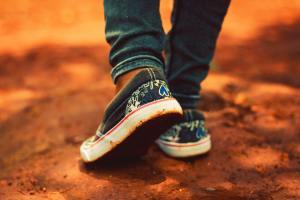
Photo by Nicholas Githiri from Pexels
Kids probably have more interesting pastimes nowadays, what with video games and everything, but does anyone Of A Certain Age, like me, remember playing “Mother, May I?”
One kid would be “Mother” and stand facing a row of other kids some distance away. “Mother” would say something like “Take three giant steps,” or “Take two baby steps,” etc. And the other kids would take their biggest or smallest steps but — and this was the catch — before taking a step everyone would have to say “Mother, may I?” After getting the “Yes, you may” you could proceed, with the goal being to be the first to cross the line in front of Mother. However, if you took a step forward on command without asking for the all-important permission, the kid playing “Mother” would screech in the tones of a vindictive banshee: “GO RIGHT BACK YOU FORGOT TO SAY MAY I!!!!” And you’d go right back to the starting line, even if you were only one baby step away from the finish.
What a weird form of entertainment. It’s a darned good thing they invented video games.
It was devastating, having to go back to right where you started when you’d made so much progress. When the end was in sight, your feet were close to the finish line. All because of one little careless slip — all that progress erased.
I’ve been thinking about that game a lot lately, that crushing feeling of being sent back to the start.
It’s easy for most of us to remember 11 months ago. Mid-March, 2020. For me, March 20, 2020 was the day Emma came home from college, her school having closed more than a month early. Jason and I had just been moved to working from home. A global pandemic was unfolding and in less than a week we’d gone from “Oh, that won’t really affect us here, will it?” to a province-wide shutdown of pretty much everything. Orders to stay home, avoid close contact even with loved ones outside our houses, go out as little as possible. Not that there were many places to go.
Well, you remember. You were there. We all were.
Over the next 11 months, those of us living here in Newfoundland had an experience shared by people in only a few other places in North America (and of course several places outside it). We went through lockdown. The initial outbreak was brought under control. Case numbers dwindled, then stopped altogether. Lockdown restrictions eased. We congratulated ourselves. We’d done it right, we’d “flattened the curve.”
We looked at people in other places, with their fluctuating or still-rising case counts and death toll, their cycles of restrictions, re-openings, and more restrictions — and we felt sorry for them. We had a nearly-normal summer and fall. Sure, we didn’t get to have the Regatta or the Folk Festival or a lot of other big sporting and cultural events — but we spent time with friends and family, ate in restaurants, enjoyed staycations, shopped and worked almost like normal, except for masks and distancing. We tracked the daily case counts, but live news briefings slipped from daily to three times a week to once a week, and the only cases we heard about were travel related, isolated, quickly contained.
We’d done it right. We had (most of us — enough of us, anyway) followed the rules. Taken each step forward, from Alert Level 5 to 4 to 3 to 2, restrictions rolling back at each step, always asking “Mother, May I?” and getting the go-ahead before moving another step back to that blessed, uncomplicated state that we remembered as “Normal.” The answer was always “Yes, you may.”
By December, when the first vaccines started rolling out, that finish line was in sight. Yes, the vaccines were slower coming than we’d hoped, but we got all the way to Christmas and two weeks past it without any major outbreaks. Case counts stayed low, and it seemed possible we’d get past the one-year mark and into spring without a second wave of COVID. And by the time summer 2021 came around, enough people might have been vaccinated that we could breathe a sigh of relief and feel we were pretty much out of danger. We would step across that finish line successfully, winners of the game.
That, of course, is not what happened.
February 20, 2021 finds me where last March 20, 2020 did (though without the pleasure of my daughter being home; she’s back in university in Nova Scotia, which, currently, is still stepping forward in an orderly fashion without any new outbreaks). I’m sitting with my laptop in my recliner by the window, watching the quiet street outside, with no plans for the evening beyond TV and board games at home. We had tickets for a concert tonight, purchased two weeks ago in a more optimistic time, but it’s been cancelled. As has almost everything else. Back in lockdown again.
There was something about hearing Dr. Janice Fitzgerald’s words last Friday night — Feb. 12, 2021 — at the emergency evening press conference when she announced that our current outbreak was caused by the B117 variant — that almost broke me. It was when she said, “We are back in Alert Level 5,” and I swear I heard a little quaver in her voice, that voice we’ve all relied on for eleven months to deliver the news in a steady, trustworthy tone.
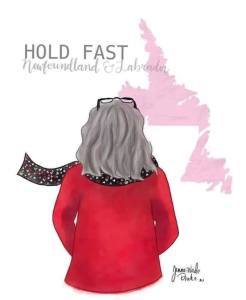
Artist: Jenna-Wade Drake
Back. In Alert Level 5. Back to the tightest possible restrictions, full lockdown, no hugs with extended family, no small get-togethers with half a dozen friends. No teaching in-person for me, even with the rituals of wiping down tables and the sheets of plexiglass Jason had carefully installed in my classroom just a few weeks earlier. No more gathering in church, even with masks on for singing as we’d done since September. No more stopping into Chapters for a book or Starbucks for a coffee – stores open for essential shopping only.
Go right back, you forgot to say May I.
We’re doing the right thing, of course — if there’s an outbreak of the newer, highly contagious variant in a population where few people are vaccinated and there’ve hardly been any COVID cases for months, a tight lockdown is exactly the way to get it under control. And we never did get any guarantees that we were living in a magical wonderland where viruses couldn’t penetrate. We were always at risk: luck, compliance, and geographical isolation were just on our side for several months until, suddenly, they weren’t.
For me, at least, what’s been hard about second lockdown so far is that “Mother, May I?” feeling. We were so close to coming out the other side of this — that’s how it felt anyway. I find it much easier to cope with things, even difficult things, if I feel like I’m making progress. Like every step, however difficult, is a step in the right direction, towards the goal. If I can see the finish line and each moment brings me closer to it.
I think most of us are like that. We want to believe in life as an orderly progression towards a goal. Yes, there’ll be tough times, but we’re getting there. In our careers. In childraising. In spiritual life. In overcoming addictions. In battling physical or mental illness. The steps along the way may be hard, but we can bear it as long as they’re moving us close to a goal.
So often, though, life is like that childhood game. We move forward — sometimes with giant steps, sometimes with baby steps — closer to that goal. Then, suddenly, out of nowhere, the unexpected setback. The layoff. The relapse. The variant outbreak. The thing we thought we were safe from, knocking us squarely back to start. Go right back; you forgot to say may I.
And along with the loss, along with the vision of all the ground we have still to cover, there’s that angry whine of unfairness: But I was so close! We were nearly there!! I took all the right steps in the right direction!! Why do we have to go all the way baaaaack?? It’s not faaaiiirrr!!
That’s the voice I’ve been hearing in my head a lot over the past week. Knowing that this is how things work, not just in pandemics but in life, helps a little.
But only a little.
I still want that finish line.
The Thursday Murder Club, by Richard Osman
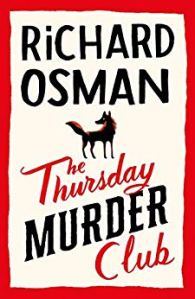 This new and wildly popular mystery novel from UK game show host Richard Osman carries the same unspoken (or rarely-spoken) concern that comes with a lot of books by high-profile people who didn’t originally make their name by writing novels: Can a book by a celebrity actually be any good? In this case, The Thursday Murder Club stands on its own feet as an enjoyable and engaging mystery novel, whether you’ve ever heard of its author in any other context or not.
This new and wildly popular mystery novel from UK game show host Richard Osman carries the same unspoken (or rarely-spoken) concern that comes with a lot of books by high-profile people who didn’t originally make their name by writing novels: Can a book by a celebrity actually be any good? In this case, The Thursday Murder Club stands on its own feet as an enjoyable and engaging mystery novel, whether you’ve ever heard of its author in any other context or not.
The premise of the novel is that four people living in an upscale retirement community meet weekly to discuss and analyze cold-case murders and see if they can sovle them — just to keep their minds sharp, you understand. These four seventy-somethings all have backgrounds that lend something to the task: Elizabeth, the group’s leader, never says exactly what she did in her pre-retirement life, but she clearly worked in British intelligence; Ron is a former union leader and rabble-rouser; Ibrahim is a psychologist, and Joyce a retired nurse. Joyce is the only one of the characters whose chapters are sometimes told in first-person, since she keeps a diary; she has only recently been brought into the group as a replacement for Penny, a former police officer now sidelined by serious illness. The core group and all the people around them make up a vivid and lively community, a constant reminder that people don’t stop being interesting, or interested, simply because they’ve retired.
Of course, a real murder — then another! — soon occurs in the otherwise-quiet community, and the members of the Thursday Murder Club, assisted by two very different and memorable police officers, Donna and Chris, set themselves the task of solving it. The journey to get there is thoroughly enjoyable and page-turning, although I thought that the solution of at least one part of the mystery — the motive for the second murder — was extremely flimsy. However, this didn’t detract from my pleasure in reading the story, and if there is another Thursday Murder Club novel coming (as I hear there is) I will certainly be reading it.



